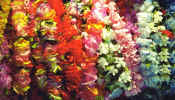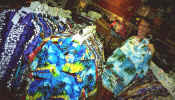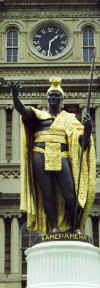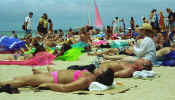Honolulu
Monday 10 July – Wednesday 12 July 2000
 It
took a while for Pippa to explain why, although she’d been told it wasn’t
worth the trouble (principally by her husband), she still wanted to visit
Hawaii. Maybe it was the exotic dream you grow up with: girls in
hula skirts and flower garlands dancing under a palm
It
took a while for Pippa to explain why, although she’d been told it wasn’t
worth the trouble (principally by her husband), she still wanted to visit
Hawaii. Maybe it was the exotic dream you grow up with: girls in
hula skirts and flower garlands dancing under a palm tree on a pristine white sandy beach, or men in skimpy bathing suits with
surfboards under their arms and all-over body tans.
Whatever it was, Pippa was determined we were not going to return home
without having first stopped off in Hawaii, even if it was to see for herself
how tacky this packaged paradise had become.
tree on a pristine white sandy beach, or men in skimpy bathing suits with
surfboards under their arms and all-over body tans.
Whatever it was, Pippa was determined we were not going to return home
without having first stopped off in Hawaii, even if it was to see for herself
how tacky this packaged paradise had become.
With only ten days at our
disposal, we once again had to be selective with respect to the things we could
see and do. The major sights of
Honolulu were a must, as was a check up at the hospital, just to set our
midwife’s mind at rest and confirm that everything was going according to
plan.
 Situated
on Hawaii’s most developed island of Oahu, Honolulu is a modern city with an
intriguing blend of Eastern and Western influences.
It is made up of two main parts: Waikiki, once Hawaii’s only tourist
destination and still the package tourist’s Mecca: and downtown Honolulu, a
mixture of old and new, past and present, sleek new high rises mingling with
stately Victorian-era buildings. We
started with the more cultural side of the city, and with guidebook in hand
walked around Iolani Palace (the only royal palace in the US), the Hawaii State
Library, the modernistic State Capital building, the coral-block New England
Missionary and the Spanish-style City Hall.
Opposite the Iolani Palace stands the Aliionlani Hale, the first major
government building constructed by the Hawaiian monarchy and overlooking it, a
statue of King Kamehameha the Great.
Situated
on Hawaii’s most developed island of Oahu, Honolulu is a modern city with an
intriguing blend of Eastern and Western influences.
It is made up of two main parts: Waikiki, once Hawaii’s only tourist
destination and still the package tourist’s Mecca: and downtown Honolulu, a
mixture of old and new, past and present, sleek new high rises mingling with
stately Victorian-era buildings. We
started with the more cultural side of the city, and with guidebook in hand
walked around Iolani Palace (the only royal palace in the US), the Hawaii State
Library, the modernistic State Capital building, the coral-block New England
Missionary and the Spanish-style City Hall.
Opposite the Iolani Palace stands the Aliionlani Hale, the first major
government building constructed by the Hawaiian monarchy and overlooking it, a
statue of King Kamehameha the Great.
 In
stark contrast to the cultural edifices of Honolulu is Waikiki, packed with high
rise hotels along a two-mile stretch of white, sandy beach delivered here by
dump trunk. During the day every
inch of beach is crowded with package tourists catching the rays and soaking up
'paradise', and at night the streets are packed with the same holidaymakers
looking for a little action. It's all very exciting, if you're 15.
In
stark contrast to the cultural edifices of Honolulu is Waikiki, packed with high
rise hotels along a two-mile stretch of white, sandy beach delivered here by
dump trunk. During the day every
inch of beach is crowded with package tourists catching the rays and soaking up
'paradise', and at night the streets are packed with the same holidaymakers
looking for a little action. It's all very exciting, if you're 15.
For us the most interesting part of Honolulu’s sightseeing circuit
lay beyond
the city centre at Pearl Harbour. Here
on December 7, 1941 a wave of more than 350 Japanese planes attacked the US
Pacific Fleet. The USS Arizona sank
within nine minutes of being bombed and with it 1,177 soldiers, almost half the
total number that died during the two-hour attack.
Now the Arizona is a memorial to all those who died and over 1.5 million
people, many of them Japanese, come here each year to remember Pearl Harbour and
honor the dead.
It was a moving experience
watching the documentary film on the attack and envisaging the mayhem that
ensued as you look out over the harbour. A boat ride took us out to the Arizona, where we stepped off
onto a 184 foot memorial situated over the sunken vessel, and looked down onto the
sunken ship below. It is the final
resting place for almost all the 1,177 men who died on board that fateful day,
and is a stark reminder to everyone who visits of the tragedy and futility of
war.